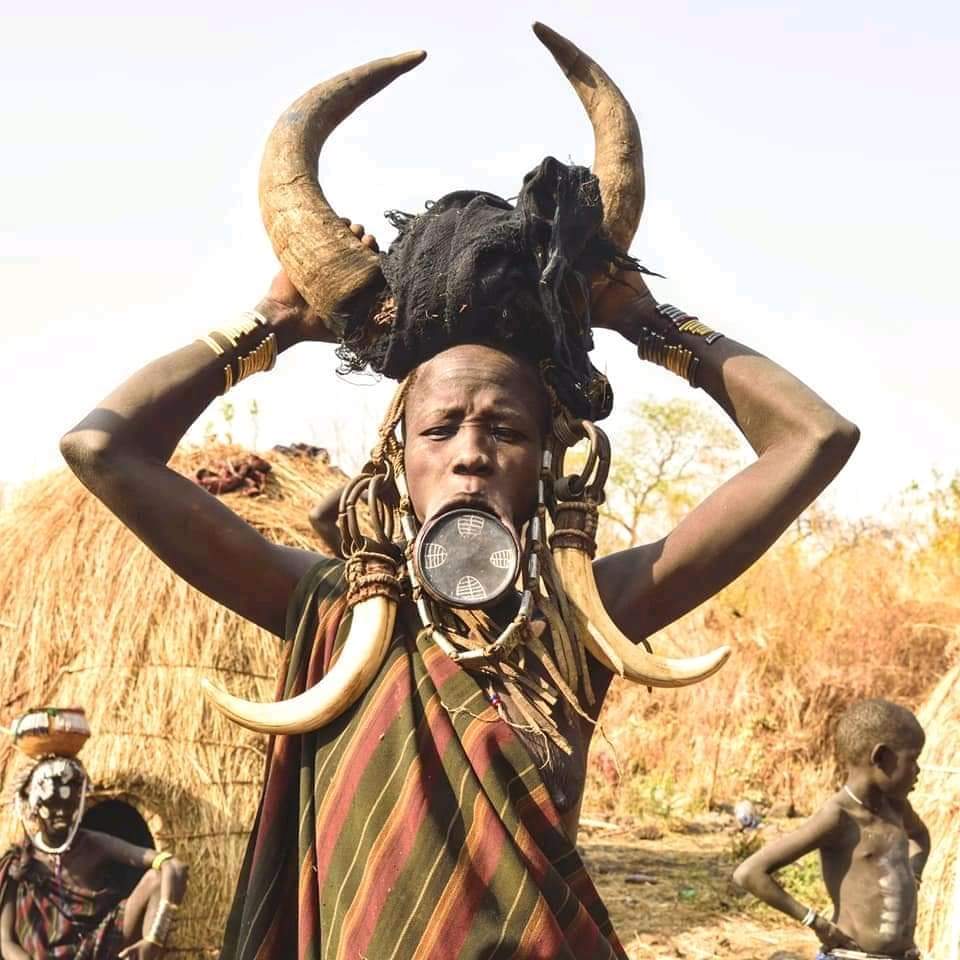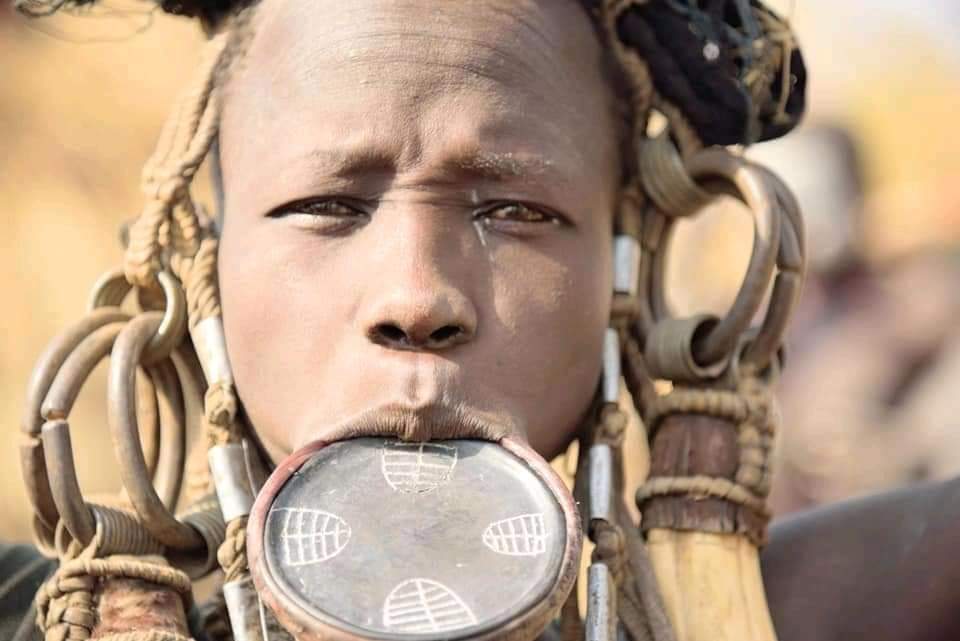The Mursi tribe, with a population of around 10,000, is well-known for their unique tradition of wearing clay discs on their lower lips, known as the Mursi Women’s lip plate. They also have a reputation as the fiercest warriors in the Omo Valley. Life for the Mursi tribe is tough and sometimes dangerous due to conflicts between different tribes and raids on cattle. Despite these challenges, they have managed to adapt and thrive in the harsh conditions of the Omo Valley.

They proudly identify themselves as the Muni people and share a language with the Surma tribes, although there are some dialect differences. In fact, intermarriage between the Mursi and Surma tribes is quite common, further strengthening their bond.
Where is the Mursi tribes are found
The Mursi Tribes are found in south Ethiopia, in the Omo Valley, Salamago district, nestled between the Omo River to the west and the Mago River to the east. The Nearest Mursi Village is found 50 – 60 KM from Jinka Town, inside of Mago National Park.
In the past, the Mursi tribe used to live in the Bish area of the Bench Maji Zone, located to the west of the Omo River. They were often described as nomads, but now they have adopted a more settled lifestyle in villages. The men still move around to find suitable grazing areas for their livestock, while the families remain in the villages. They practice flood retreat cultivation along the banks of the Omo River, making the most of the resources available to them.
Way of Life
The Mursi people primarily engage in pastoralism, with cattle serving as a significant indicator of wealth and being highly valued possessions. In fact, individuals are even named after the color of their favorite cattle.
In terms of agriculture, the Mursi practice flood retreat cultivation and rain-fed cultivation in the bush. They clear a specific area of land, plant crops, and then move on to a new location once the soil has been depleted. This approach allows the land to regenerate and ensures a sustainable source of food for the Mursi community.
The main crops cultivated by the Mursi include sorghum, corn, beans, chickpeas, and tobacco. Additionally, sorghum and maize are used as staples in their daily diet. Various plant species are also utilized as vegetables.
The Mursi people have a unique and uncomplicated diet, relying heavily on their cattle for sustenance and consuming their products in various forms. Their diet primarily consists of milk, meat, and blood obtained from their livestock. The consumption of fresh blood is considered a sacred and customary practice, achieved by piercing the cow’s neck with a bow and extracting the blood. On occasion, blood is mixed with milk to create a nutritious beverage. Despite its simplicity, the Mursi Tribe’s diet provides them with the essential nutrients required for their daily lives.
Mursi Village
The Mursi villages are Scatered inside the Mago National Park. Typically, a Mursi village comprises a dozen small huts constructed from grass and wood. These structures are circular in shape and have thatched roofs, which are carefully layered with long grass to provide insulation from the African sun and prevent leaks during heavy rainfall. Notably, the Mursi houses lack windows and have small doors that are short in height and size, requiring one to bend over and crawl to enter. This design is intended to prevent animals and enemies from easily entering the house. The interior of the Mursi house is small, simple, and functional, with the main living area serving as a multipurpose space for preparing food, eating, keeping important items, and sleeping.
The village is typically established near a water source and centered around a forest, where large trees serve as a gathering place for the community. These trees are often used for shade during the day and as a meeting place for important discussions and decisions. The Mursi also prefer areas suitable for farming, with crops typically grown in small plots of land surrounding the village. The traditional dwellings of the Mursi provide a glimpse into their daily lives, allowing for a deeper understanding of their way of life.
Donga Dueling
The Donga ceremony is a highly esteemed event that showcases a fierce stick fight between men from various Villages. This tradition holds great prominence within the Mursi community and is conducted following each successful harvest season. They take great pride in their tradition of combat. It is a legacy passed down from generation to generation, a testament to their resilience and courage. It is a thrilling spectacle that showcases the indomitable spirit of The Mursi people, a reminder of their strength and their commitment to upholding their proud traditions.
As they grow older, the Mursi boys eagerly anticipate the day they can participate in the Donga ceremony. This ceremony is not for the faint of heart, as it involves intense stick fights between men from different Villages. The stakes are high, and the battles are fierce, with each warrior striving to prove his strength and bravery.
The combatants aim to strike their Opponent with precise and calculated strikes with a Dueling Stick, while simultaneously avoiding being hit. The dueling stick, measuring two meters in length, serves as the primary weapon for striking opponents. This Fighting is potentially fatal, necessitating the use of protective measures such as a small basket on the hand, animal skins, and various materials positioned strategically across the body. Additionally, a leather skirt and cotton cloth covering the head are employed for further safeguarding. The presence of dueling scars is regarded as an emblem of strength.
Lip plate Beautification

The Mursi people have a longstanding tradition of wearing a lip plate, which is regarded as a symbol of beauty and signifies a woman’s maturity and readiness for marriage.
Upon reaching the age of 16, a girl’s lower lip is pierced and a small stick is inserted. This stick is gradually replaced with a larger clay plate, widening the lip over a period of several months. The young woman must endure the discomfort of having progressively larger clay disks inserted, some of which can measure up to 12 centimeters.
Despite the physical challenges associated with wearing a lip plate, many Mursi women take pride in their appearance and view it as an integral part of their cultural identity. However, this practice has faced criticism from those who consider it a harmful culture.
Social structure
In the Mursi ethnic group, there are two main clans, called Kutame and Shaka. These two main clans have at least 14 subclans!
Let us now talk about their social structures. They have these four ranks that govern their society: Kumuru, Koise, Herhato and Kamis. I will explain:
First, we have the Kumuru, The Kumuru (Chief) is an administrative and spiritual leader and is elected by the Kumerete and Kumai tribes.
Kumuru: Manage people.
Koise: He is the king’s advisor and enforcer.
Herhato: He is a dreamer and a prophet.
Kamis: It is the lowest power structure in the nation and connects the people and the governing body.

Pingback: Tribes of Omo Valley Ethiopia - My Ethiopia Tours